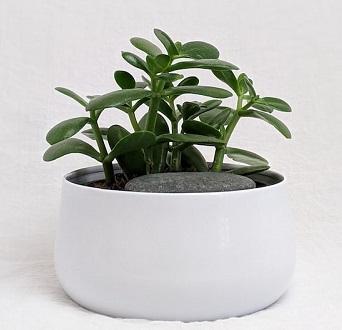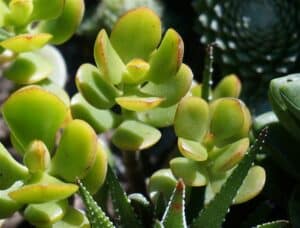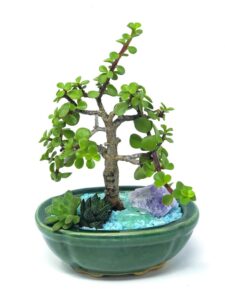Jade plants are popular indoor plants because they are low-maintenance and appealing. Jade plants need maintenance like any plants. Pruning jade plants promotes growth, health, and attractiveness.
How To Prune a Jade Plant?
Pruning Jade plant start with trimming off any damaged leaves, stems, or branches. Cleanly cut the plant’s base. This prevents bugs and infections. Trim overgrown branches and stems to shape your jade plant. Cut above nodes to allow fresh growth. Leave adequate foliage: Leave enough foliage for plant development and health. Avoid cutting more than one-third of the plant at once to avoid shock and impede development.
Pruning might be intimidating for beginners. Based on Google’s top-ranking articles for this term, we’ll show you how to prune a jade plant step-by-step. To keep your jade plant healthy and bright, we will discuss trimming and typical errors.
| Specification | Description |
|---|---|
| Plant | Jade Plant (Crassula ovata) |
| Pruning Type | Young and very large branches |
| Tools Needed | Clean, sharp pruning shears or scissors |
| Timing | Best time to prune is during the growing season in spring or summer |
| Procedure | Identify branches to be pruned, cut branches at a 45-degree angle just above a leaf node or joint |
| Purpose | To maintain the plant’s shape and size, promote new growth, and remove damaged or diseased branches |
| Environment | Native to South Africa, but widely cultivated as a houseplant or outdoor plant |
| Appearance | Succulent plant with thick, fleshy leaves and woody stems |
| Light Requirements | Bright, indirect light or filtered sun exposure |
| Water Requirements | Infrequent watering, allowing soil to dry out between waterings |
| Soil Requirements | Well-draining soil with a pH of 6.0 to 7.5 |
| Maintenance | Minimal maintenance required, occasional fertilization to promote growth, prune to maintain shape |
What a jade plant?
The “money tree” or jade plant, Crassula ovata, is a succulent houseplant. It is native to South Africa but planted worldwide in gardens and homes. Jade plants have strong, woody stems and lustrous, oval-shaped leaves. They are great for indoor gardening since they grow in low light and are decorative.
Importance of pruning jade plants
Pruning keeps jade plants healthy and attractive. Pruning properly boosts plant health, leaf density, and structure. Eliminating dead, diseased, or damaged plant portions prevents pests and illnesses. Pruning also stimulates stem development in overgrown jade plants. Pruning may also shape the plant and keep it manageable. Regular trimming helps jade plants stay healthy and appealing for years.
According to an article on wisc.edu, it is recommended to prune the roots when repotting the plant into the same-sized pot. Additionally, cutting back the stems is advised to retain the desired shape and promote the growth of a robust main trunk.
Brief overview of the pruning process
Pruning removes leaves, stems, and branches from a plant to enhance its health or form. Pruning helps jade plants develop, eliminate dead or damaged portions, and look good. Pruning controls plant size and prevents overgrowth. Pruning encourages new growth, making the plant bushier. To prevent plant damage, prune using sharp, clean instruments. Pruning is vital to jade plant health and lifespan.
When to prune a jade plant
Jade plants need timely pruning to thrive. Signs a jade plant requires pruning:
- Leggy or overgrown.
- Dead, damaged, or discolored leaves or stems
- Crowded or crossed branches
- Uneven growth
- Stretching too much
- Excessive drooping
According to a resource on North Dakota State University, it is indeed possible to prune a Jade Plant. If the stems begin to appear elongated or leggy, it is recommended to trim them back to maintain a more compact and healthy appearance.
Factors that determine when to prune
While pruning a jade plant, consider its growth cycle, environment, and health. While it’s growing, jade plants are best pruned in spring or summer. Avoid trimming dormant plants in winter. Before pruning, check for pests and illnesses. Pruning may injure a stressed plant further. To maximize jade plant growth, pruning time should be addressed.

Benefits of pruning at the right time
Pruning a jade plant properly has several advantages, including:
- Pruning removes dead or damaged plant components and promotes new shoots and leaves.
- Pruning shapes the plant and keeps it manageable.
- Remove dead or damaged plant portions to avoid disease and insect infestations.
Pruning encourages fresh stem development from the base of an overgrown jade plant. - Pruning improves the plant’s appearance by keeping it compact and beautiful.
Yet, improper pruning may limit development, increase pest and disease susceptibility, and weaken the plant. So, the optimum results for the jade plant depend on trimming timing.
Tools needed for pruning a jade plant
List of necessary tools
The following tools are essential for pruning a jade plant:
- Pruning shears: Cut little branches and stems precisely.
- Tiny scissors may cut dead leaves and stems.
- Garden knife: For heavier branch cutting.
- Gloves protect your hands from thorns and other dangerous edges.
- Rubbing alcohol or bleach are used to disinfect equipment before and after use.
Note: Sharp and clean pruning tools avoid plant damage and disease transmission.
Explanation of how to use each tool
Here’s an explanation of how to use each tool for pruning a jade plant:
- Pruning shears remove tiny branches and stems precisely. Hold the shears near to the base of the branch or stem to be removed and make a clean cut just above the node or junction where the leaf joins the stem. Cut away from the node to avoid crushing the stem.
- Tiny scissors may cut dead leaves and stems. Use scissors to cut the leaf or stem between your thumb and fingers.
- A garden knife may cut tougher branches. Cut the branch at a 45-degree angle while holding it with one hand. Cut slightly above the leaf-stem node.
- Gloves: Use gloves while trimming jade plants to avoid thorns and other sharp edges. Select gloves that fit comfortably and are puncture- and cut-resistant.
- Sterilize instruments before and after pruning with rubbing alcohol or bleach. This prevents infections and cleans your instruments for the next pruning session.
Consider plant size and cut type while choosing equipment. A garden knife may be needed for bigger plants or branches, although pruning shears or scissors may work for smaller ones. To cut cleanly, use the right instrument.
Safety precautions to take when using the tools
To avoid harm, use safety gear while cutting jade plants:
- To avoid thorns, sharp edges, and other risks, wear gloves.
- Sharp tools prevent slips and injuries. Sharpen instruments for smooth cuts.
- Utilize the correct tool: Accidents might result from using the wrong tool. Use the correct tool.
- Use tools properly to avoid harm. Follow the manufacturer’s directions for each tool.
- Clean and sharpen your equipment after use to minimize plant damage and disease spread.
- Keep tools out of reach of youngsters and pets.
These safety measures will make trimming your jade plant safe and effective.
Steps for pruning a jade plant
Preparation before pruning
Do these measures before cutting your jade plant:
- Check for sickness, damage, and insects. To avoid plant harm, correct any concerns before trimming.
- Clean and sharpen your pruning instruments.
- Choose pruning areas: Locate plant pruning locations. Dead, damaged, or diseased branches, or overgrown or leggy sections, are examples.
Techniques for pruning
Depending on your goal, you may trim your jade plant in many ways. How to make three typical cuts:
- Heading controls plant size and form. Heading cuts are made by clipping the stem directly above a leaf node. This encourages fresh growth underneath the incision.
- Thinning: To allow ventilation, whole branches or stems are removed. Use pruning shears or a garden knife to clip the stem immediately above where it joins another branch or stem to thin it.
- Pinching promotes bushy growth and prevents legginess. Pinch fresh growth tips using fingers or scissors to perform a pinching cut.
How to care for the plant after pruning
Care for your jade plant after trimming to encourage healthy development and reduce stress. Tips:
- After pruning, water the plant well to moisten the soil.
- After trimming, apply a balanced, water-soluble fertilizer to promote new growth.
- Proper lighting: Keep the plant out of direct sunshine, which may burn recently cut regions.
- Monitor the plant: After trimming, check the plant for stress or injury.
These methods will help your jade plant recover fast and flourish after trimming.
How to Prune a Jade Plant

Jade plants are gorgeous succulents with thick, meaty foliage and little maintenance. Pruning a jade plant frequently promotes growth and health. Jade plant pruning instructions:
- Pick the proper time: Prune jade plants in spring or summer, when they’re actively growing. This aids plant recovery and development.
- Find overgrown, damaged, or dead areas to trim. Branch, leaf, and stem examples.
- Tools: Avoid plant damage with sharp, clean pruning shears or scissors. Rubbing alcohol cleans instruments.
- Prune: Remove any damaged leaves, stems, or branches. Cleanly cut the plant’s base. This prevents bugs and infections.
- Trim overgrown branches and stems to shape your jade plant. Cut above nodes to allow fresh growth.
- Leave adequate foliage: Leave enough foliage for plant development and health. Avoid cutting more than one-third of the plant at once to avoid shock and impede development.
- Clean up: Clear rubbish and leaves surrounding the plant to prevent pests and illness.
- Check the plant’s recovery after trimming. Water and warm the plant.
These measures will maintain your jade plant healthy and beautiful. For healthy development, trim your jade plant frequently.
Common mistakes to avoid when pruning a jade plant
Over-pruning

Overpruning may stress jade plants and stunt their development. Over-pruning causes stunted growth, yellowing leaves, and weakness. Never prune more than one-third of the plant’s leaves at a time to prevent over-pruning.
Improper use of tools
Using the incorrect instrument or poorly may harm plants and injure pruners. Dull or rusted instruments may cause jagged cuts that harm plants and increase disease risk. Pruning shears may destroy bigger branches if used poorly. Use the right tool and follow the manufacturer’s instructions to prevent these complications.
Pruning during the wrong time of year
Pruning a jade plant at the incorrect season may stress and destroy it. Pruning a dormant plant in winter or spring might impede its growth and recovery. Prune jade plants in spring or summer to prevent this. Pruning amid drought or high heat might stress the plant.
How to Prune a Young Jade Plant
Young jade plants are easier to prune. Step-by-step instructions:
Materials:
- Pruning shears, gloves
- Sterile rubbing alcohol or hydrogen peroxide
Instructions:
- Wipe your pruning shears with rubbing alcohol or hydrogen peroxide to sterilize. This prevents bugs and infections.
- Identify pruning’s objective. Branching helps jade plants grow fuller.
Find branches to prune. Look at each branch’s fresh leaves. - Cut or pinch each branch’s fresh leaves. This will promote branching and fuller jade plants.
- Just prune one-third at a time. Stress may stunt or kill the plant.
- Repeat every few months to stimulate branching and a bigger plant.
How to Prune a Very Large Jade Plant

If neglected, jade plants may develop into enormous, unmanageable trees. A huge jade plant may be pruned step-by-step:
Materials:
- Pruning shears, gloves
- Sterile rubbing alcohol or hydrogen peroxide
Instructions:
- Wipe your pruning shears with rubbing alcohol or hydrogen peroxide to sterilize. This prevents bugs and infections.
- Identify pruning’s objective. Trim all side stems by half to develop your jade plant upward. Shorten the trunk by one-third for outward expansion. Relief pruning is needed for drooping branches.
- Find branches to prune. Check for branches that are crossing, rubbing, dead, infected, or growing in the wrong direction.
- Trim detected branches. Cut the branches neatly and slightly angled using sterilized pruning shears. Cut away from the main stem to avoid plant harm.
- Don’t prune more than one-third at a once. Stress may stunt or kill the plant.
- Just prune fresh shoot tips. This will boost growth and avoid legginess.
Conclusion
Summary of the key points
- Pruning keeps jade plants healthy and attractive.
- Only prune in the growth season.
- Pruning should be done using shears and rubbing alcohol.
- Avoid over-pruning, tool misuse, and seasonal pruning.
Final tips for successful pruning
- Start with a strategy and know what to prune.
- Create smooth 45-degree cuts without rough edges.
- Prevent illness and pests using pruning sealant on bigger cuts.
- Check the plant for pests and diseases and respond quickly.
Importance of maintaining a healthy jade plant
Healthy jade plants improve air quality, reduce stress, and beautify your home. Appropriate pruning, watering, fertilizer, and sunshine are necessary for plant health and lifespan.
In conclusion, trimming a jade plant may boost growth, health, and look with the correct tools, methods, and timing. Avoiding frequent errors and following this guidance can help your jade plant survive for years.
Related Posts:
Check out this article on caring and growing tips on jade plant
What Does a Leggy Jade Plant Look Like? 5 Main Causes (& Fix)
Jade Plant Branches Top Heavy – 3 Main Causes And Fix
Jade Plant Cannot Support Itself – Main Causes Why It Falls?
Jade Plant Meaning – Symbolism(Spiritual), Feng Shui
6 Amazing Benefits of Jade Plant, Uses(Superstition, Feng Shui)
Are Jade plant Toxic to Cats? – Humans, Dogs(Is It Safe)
